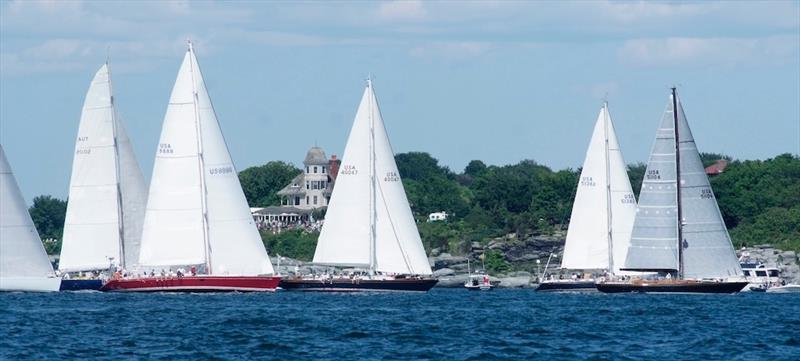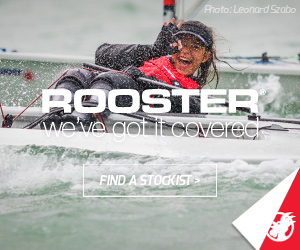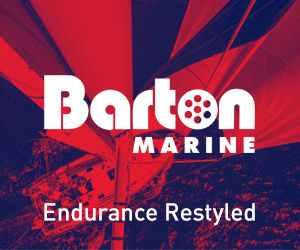
51st Newport Bermuda Race - Preview
by Chris Museler 4 Mar 15:21 UTC 15 June 2018 The 2014 Cruiser Division start off Castle Hill, Newport, turned out a good spectator fleet, as usual. © Barry Pickthall / PPL
The 2014 Cruiser Division start off Castle Hill, Newport, turned out a good spectator fleet, as usual. © Barry Pickthall / PPL
When as many as 200 sailing yachts head southeast in June, they'll be competing in several races within the race.
Organized by the Cruising Club of America and the Royal Bermuda Yacht Club, the Newport Bermuda Race is one of the world's greatest and most historic ocean races.
On Friday, June 15, 2018, after months of rigorous yacht and crew preparation, the biennial 635-mile challenge starts in Newport, Rhode Island, off Castle Hill's magnificent rock ledge. Days later, it ends in the mid-Atlantic at the exquisite sub-tropical island of Bermuda. The reward for the crews is both the race and the destination.
This year's 51st edition of the race is limited to 220 entrants, and of those there will be a familiar collection of 150 or more approximately 40- to 50-foot boats. This group, the sailors in the St. David's Lighthouse and Finisterre divisions, is the race's largest constituency. The remaining 70 or so boats will comprise the Gibbs Hill Lighthouse, Superyacht, Open, Spirit of Tradition, Double-Handed and Multihull divisions.
Each division has its own unique and differentiating characteristics. The technical details are defined precisely in the Notice of Race, but here's a quick summary. The St. David's Lighthouse Division is the amateur helmsman racer/cruiser division; the Finisterre Division (previously known as the Cruiser Division) is a performance cruising division with amateur helmsman and limits on spinnakers and other downwind sails. The Gibbs Hill Lighthouse Division is for high(er)-tech, faster boats and with no limitation on the number of pros aboard; the Superyacht Division is for yachts over 80 feet. The Open Division is for high-tech and experimental boats that don't fit into other divisions due to features such as lifting foils. The Spirit of Tradition division is for "traditional" vessels over 55 feet, such as the Bermudian training sloop Spirit of Bermuda and the schooner America. The Double-Handed division is for 2-person crewed yachts; and the new Multihull division is for catamarans and trimarans 58 feet or larger.
The divisions within the race have been increased and reconfigured over the years to reflect the diversity of amateur and professional crews wishing to compete, as well as the evolution and advancement of yacht design, engineering and construction. Fair and safe competition that encourages continued participation are guiding principles of The Bermuda Race Organizing Committee, a joint committee of CCA and RBYC members.
Reflecting on the guiding principles of the race, the commodore of the Cruising Club of America, Herbert L. Stone, stated in 1923 that the race was founded "to encourage the designing, building, and sailing of small seaworthy yachts, to make popular cruising upon deep water, and to develop in the amateur sailor a love of true seamanship, and to give opportunity to become proficient in the art of navigation."
With these principles in mind and after careful consideration and extensive study, the 51st Bermuda Race will be a milestone year for the event. In the Gibbs Hill Division, canting keels will now be allowed. And for the first-time, a Multihull Division will be included, with starts for catamarans and trimarans.
While the range of boats competing continues to evolve, the demographics of the race are changing, too. With youth and family participation increasing thanks to initiatives tied to new trophies, this year's race is poised to have the most diverse group of sailors and boats in the race's history.
"We continue to develop the race as technology evolves," says Jonathan Brewin, the race chairman. "Sailing as a sport continues to move forward, and this is an opportunity for us to develop our competitor base." He emphasizes that safety and seamanship remain the core principles of the race, influencing the requirements for all new additions to the fleet.
Multihulls Race for the First Time
In the past, some might have said there would never be catamarans and trimarans in the Newport Bermuda Race, that they can capsize and for that reason are inherently unsafe in an ocean race. A group of multihull owners asked to compete in the 2016 race but without safety procedures or VPP Handicaps established, a two-year wait was in order. Special safety regulations, crew requirements, and a new handicap system are now in place.
"I think it's a big deal," says Phil Lotz, owner of the Gunboat 60 Arethusa. "Of all the great ocean races in the world, only two had yet to include multihulls. Now only the Sydney Hobart is left excluding the type."
Lotz, who is commodore of New York Yacht Club, helped form the Offshore Multihull Association (OMA), an owners group, which collaborated with the Bermuda Race Organizing Committee to formalize the new inspection and safety requirements for the race. Crew requirements are more stringent for these high-performance cruiser/racer cats & tris, which regularly sail over 20 knots. Concerns also had to do with proper placement of safety gear, including liferafts as deck layouts on multihulls are uniquely different and the potential for capsize can limit access.
Safety considerations of multihulls were carefully evaluated. The race's technical committee began its research in 2014. Lotz says that it was a great learning process for both sides in determining what requirements were practical. He went on to say that all are pleased that the time has come. Expressing his satisfaction, he says, "The Bermuda Race has been something we've always really wanted to do as a group."
More Firsts in Gibbs Hill and Open Divisions
There are more firsts in the Open Division in 2018. Previously created for professionally crewed, high-performance boats that often had mechanically canting keels and water ballast, the group is now open for boats with vertical-lift foils. An Infinity 46 canting keeler with such equipment is expected to be on the start line. These "foils" slide out to leeward from the hull, horizontally, and give the boat tremendous lift, righting moment, and power. Other foil arrangements are allowed in the Open Division, but with some restrictions.
The Gibbs Hill Lighthouse division, which has allowed professional crews, is now allowing canting-keel and water-ballast boats that were once placed in the Open Division. This allowance for boats including the new water-ballasted J/121 is expected to boost participation in the division, showcasing the trickle-down of the latest in yacht design.
St. David's Lighthouse Challenge and Reward
John Osmond, Principal Race Officer, sailed his first Bermuda race in 1982 aboard his own C&C 40. The start was postponed for two days due to a gale, the remnants of which the fleet battled in the Gulf Stream. He kept coming back, excited for the adventure, and now many decades later, Osmond sees that same drive from the amateur sailors of the Bermuda Race.
"In the St. David's Division, we clearly have the same degree of excitement and effort to enhance the learning curve for all the nuances of racing in the ocean," says Osmond. "For everyone who gets to do this, it's an epic adventure."
According to race statistics, the overall fleet size has been growing in recent years, and the majority sail for the St. David's Lighthouse Trophy, an intricate, glimmering model of the race's finishing beacon at the north end of Bermuda. Actaea, a refitted Hinckley Bermuda 40, won the trophy in 2014, and although there are newer boats in this growing amateur division, the feat serves as encouragement for older, well-found boats, even if smaller and slower.
Osmond sees recent initiatives to promote youth and family participation taking hold in 2018. The Stephens Brothers Youth Division Prize, inaugurated in 2016 and won by a bright group of young Long Island Sound sailors, was inspired by legendary designers Olin and Rod Stephens. Race competitors between the ages of 14 and 23 are now inducted into the Stephens Brothers Society and receive a society pin upon reaching the docks in Bermuda.
Since the success of American Yacht Club's youth team aboard High Noon—winning class and the youth prize in 2016—the race has been fielding more interest from youth-driven teams. "There has been great interest and energy since they won their class on High Noon," says race veteran and Young American coach Peter Becker. "I think we can change the conversation in the U.S. about youth and offshore sailing." The team under Becker's leadership hopes to return in 2018 with two youth boats.
Though participation is looking strong for 2018, a large fleet is not a given, says Osmond. "There's an attrition rate each year," he says. "We have to decide if changes we make help or hurt participation, particularly in the St. David's Division." First-time competitors are normally the largest group of entrants, but the race's specialty awards, including the William L. Glenn Family Participation Prize, help raise interest and encourage returning teams.
"There's a special chemistry that exists between family on a racing boat," says D'Arcy Carr, who has raced to Bermuda five times on her family's J/44 Runaway. "You share the same DNA, so you approach things the same way. And there's the all-important ability to say exactly what you think without worrying about hurting someone's feelings."
Carr's family donated the William L. Glenn Family Participation Prize, an heirloom bronze sextant used in Bermuda Races by her uncle Will, in 2004. Four family members must be aboard to be eligible, and one must be an afterguard member.
Carr paints the picture of how a family fits the race into their lives. "We didn't do the race growing up," she says. "My dad was working. It wasn't until he was retired and we were in our 20s and early 30s when we didn't have our own children that we raced as a family."
Competitors have openly admired the Glenns and other families in the race. She says that she has seen this group grow slowly and that she hopes the next phase for her family's involvement is coming soon. "It has to be the right time of life. Of course that would be a dream to have my children there with me."
Safety and Mentoring
Of all the great ocean races, the Newport Bermuda certainly has the most rigorous inspection process for the boats and safety requirements for the crews. And the safety record is unmatched in ocean racing. Many a sailor has been overheard saying something like, "The Bermuda race has made me a safer sailor," and "I love distance racing; it's like fast cruising". These comments would surely have brought a smile to the face of Commodore Herbert L. Stone, who guided the CCA's initial involvement in the race so long ago.
The encouragement and support of sailors comes from ambassadors for newcomers, and conscientious and helpful inspectors plus the many volunteers organizing the race. John Winder, a race ambassador, inspector and former race chairman, who will be sailing his 22nd Newport Bermuda Race this year, says, "With a high number of newcomers each year, the ambassador program is very helpful in encouraging and supporting safe participation." Speaking of the rigorous requirements and inspections, Winder notes, "If we had a major gale, there's a concern there could be a lot of carnage if it weren't for the inspection process, not to mention the required safety training, preparation and experience."
New competitors, Winder says, are upping their game with more modern monohulls, increasing performance within the St. David's Lighthouse Division. The inspection process is keeping pace with these changes, says Winder, who is also a member of the race's technical committee. "We still want to provide a home for an owner with a new, fast planing boat without moving them to another division."
With the possibility of carbon catamarans and monohulls with wave-piercing vertical-lift foils lining up in front of Castle Hill this year, Winder says the stars of the Bermuda Race will still be the St. David's and Finisterre division sailors. Though we don't have one fleet, like in the Fastnet Race, we have a wonderful mix of competitors, and the race has evolved to have a number of races within the race. That's why the fleet is so strong."
https://www.sail-world.com/news/202640/51st-Newport-Bermuda-Race-previewBagikan Berita Ini


















0 Response to "51st Newport Bermuda Race - Preview"
Post a Comment